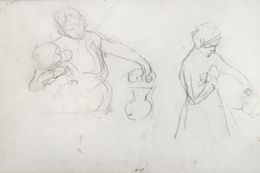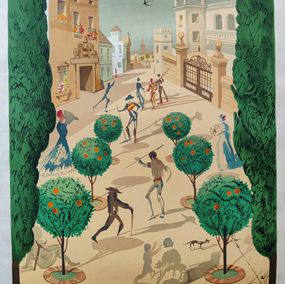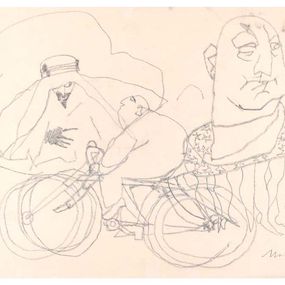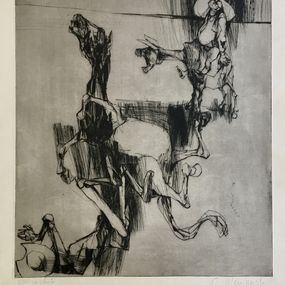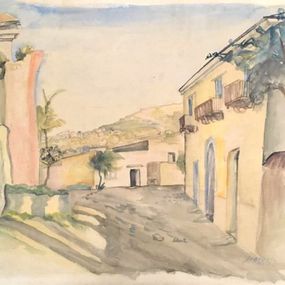
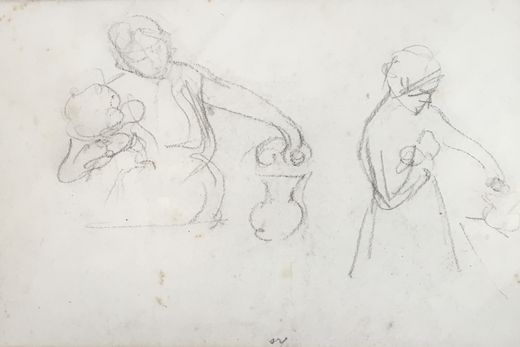
Biography
Eugène Carrière is a French painter, teacher and lithographer, born on January 18, 1849 in Gournay-sur-Marne (Seine-Saint-Denis) and died on March 27, 1906 in Paris.
Symbolist artist, he had an influence on the emergence of Fauvism.
Eugene Anatole Carrière was the son of Léon Camille Joseph Carrière, insurance director, and Élisabeth Wetzel. He was a student of Alexandre Cabanel at the École des Beaux-Arts in Paris and lived at 50, boulevard du Montparnasse in Paris at the beginning of his career.
He received commissions for paintings to decorate the Paris City Hall and the Sorbonne, as well as for religious subjects. His project for a triptych Christ on the Cross remained in draft form.
Eugène Carrière competed for the Prix de Rome in 1876, where he took first place in the sketch but failed in the stands. This piece from the competition at the Musée du Nouveau Monde in La Rochelle is on deposit at the Musée des Beaux-Arts in Pau. This work testifies to a classical education and the prevailing taste of the academy, very far from the artist's later production. The same year, he exhibited for the first time at the Salon.
He was a friend of Auguste Rodin and Antoine Bourdelle. His work influenced Henri Matisse and Pablo Picasso. Ivan Pokhitonov worked in his studio from 1877 to 1880. Carrière is also associated with writers whose portraits he painted, such as Paul Verlaine, Stéphane Mallarmé, Alphonse Daudet, Anatole France and Henri Rochefort. He expressed socialist convictions and joined the Dreyfus movement.
In 1890, he founded the Carrière Academy, rue de Rennes, where painters such as Henri Matisse, André Derain, Jean Puy, Francis Jourdain and Valentine Val studied; until 1905, he devoted himself to art classes. Eugene Carrière, who also taught at Ferdinand Humbert, the former Cormon studio, 104, boulevard de Clichy and at the Camillo Academy, Hof des Vieux-Colombier, attracted many young artists in search of freedom and independence to his academy. This place has the originality of being the breeding ground for future "Fauves" and one of the first mixed studios in Paris.
He was made a knight of the Legion of Honor in 1889 and promoted to officer in 1900.
In the summer, he regularly lived with his family, Raymond Bonheur (1856-1934), a composer in Magny-les-Hameaux, nephew of Rosa Bonheur (1822-1899).
Eugène Carrière is known for his light and dark tones of predominantly brown and gray, which blur the forms while highlighting the hands and faces. To achieve this effect, "the canvas has a smooth appearance with an almost porcelain-like surface, and the depth of the view is reproduced by scraping the canvas with the handle of the brush."
According to his first biographer Charles Morice, Paul Gauguin said of him, "The beautiful colors exist without being suspected and can be guessed behind the veil that modesty has drawn in his works. His daughters, born of love, evoke tenderness. At home, grasp and caress your hands. Her critics see her work as a form of outdated and repetitive sentimentality. Anglo-Saxon critics who echo this judgment recognize in this work the fundamental transition between tradition and modernity: his lithograph Sleep (1897) almost borders on abstraction - or at least a form of expressionism - and most of Rehkitz's painters, who paradoxically exploded the scale of colors, passed through his studio.
Eugene Carrière is the father of the sculptor Nelly Carrière (1886-1971), the father-in-law of the politician Jacques-Louis Dumesnil (1882-1956), her second husband, and the grandfather of the painter Jeannie Dumesnil (1926-2000), his daughter.
He is also the father of the painter and sculptor Jean-René Carrière (1888-1982).





